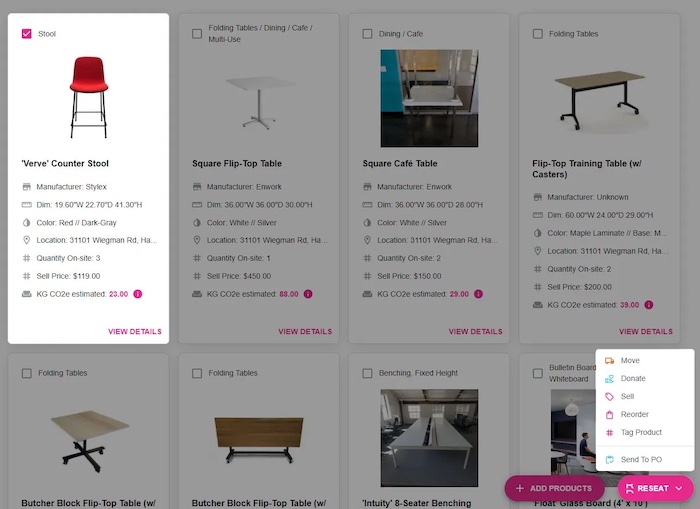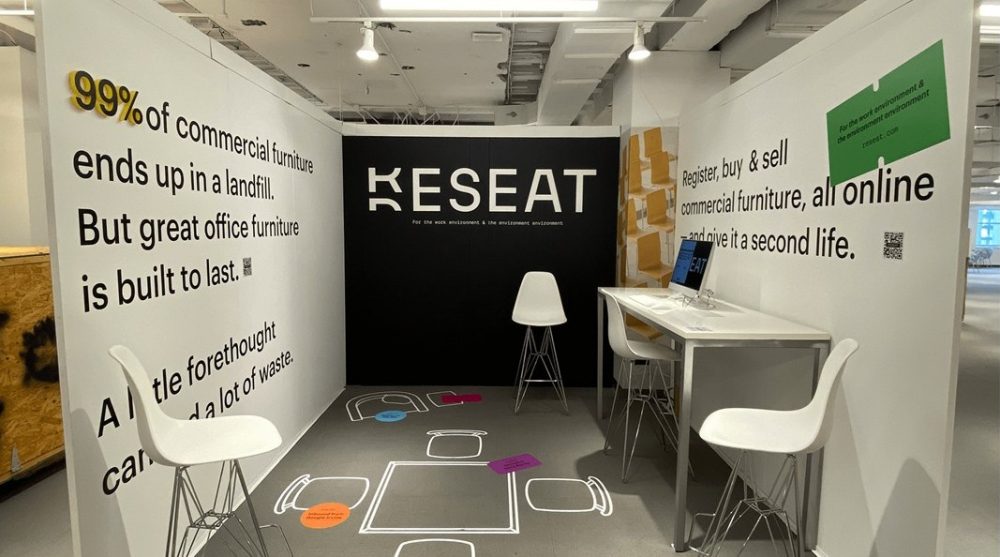The collaboration of RESEAT and Cradle to Cradle will change the way commercial furniture is managed, renewed, and repurposed to reduce waste and keep valuable materials in use.
Have you heard the news? RESEAT, a leader in sustainable, second-life furniture solutions and a SaaS (software as a service) inventory management platform is partnering with the Cradle to Cradle Products Institute, (C2C) a leader in advancing safe, circular and responsible product design. This collaboration aims to establish new industry benchmarks for sustainable furniture, enhancing the circular economy by promoting products designed for durability, recyclability and reduced environmental impact.
By collaborating, we are accelerating the transformation of the contract
furniture industry by connecting the dots between designing with circularity in
mind and end-of-life systems that power the circular economy.
— Elwyn Grainger Jones, Executive Director of C2C
Unwanted office furniture has been a landfill issue for decades. This is not just a post-Covid concern. According to the US Environmental Protection Agency, about 17 billion pounds office assets end up in landfills every year.
Returning Office Space at the End of the Lease
For decades, the conventional approach, at the end of the lease term, was for an office space to be returned to the landlord empty. A furniture liquidator was engaged to remove the furniture and other office assets, perhaps retaining a few high profile/designer pieces, or conducting an employee sale, with some going to an aftermarket, but the majority destined for the landfill.
More recently, we called this end of lease-dispose of the office furniture process decommissioning. A third party brokered the sale and/or donation of unwanted furniture, appliances, and other office assets. The devil was always in the details of understanding the product quantities/specifications and the original value. Most organizations have not maintained a comprehensive inventory of their furniture, making the reuse, sale, or donation of these assets more difficult.
Now, there are a many inventory management software options that will manage, resell and dispose of physical furniture, but first there is generally some sort of input process to catalogue asset data. And often, there are few records of furniture purchased years before. This data challenge is solved by RESEAT’s pre-project process.
Digital Product Passports
The RESEAT and C2C partnership is significant because their Digital Product Passports (DPP) establish the inventory of furniture products up front, with all the pertinent information for each item. DPPs enable project teams to think about the end in the beginning and to have a plan.
An intuitive inventory management platform, RESEAT allows the management of furniture assets across all locations in real time with the ability to move, donate, sell, renew, reorder your furniture-all while knowing your carbon footprint.
Our process…captures the order information at the time of purchase…creating a “second-life cycle” passport.
— Brandi Susewitz, RESEAT, CEO

WDM: What exactly are Digital Product Passports and why do they make office furniture more circular?
Brandi Susewitz: A RESEAT ID, also known as a digital product passport, is a unique identifier assigned to a piece of commercial furniture. It serves as a comprehensive digital record that tracks and stores key information about the furniture throughout its lifecycle. This is probably the single most important thing that users must do in order to combat the contract furniture waste problem because most companies do not have a comprehensive inventory of what they own. This makes it nearly impossible to sell because you don’t know what you can make somewhere else.
Features of the RESEAT ID / Digital Product Passport:
- Detailed Product Information: Includes manufacturer details, model, dimensions, materials used, and date of production.
- Ownership History: Tracks previous owners and locations, creating a transparent chain of custody.
- Condition & Maintenance Records: Logs updates like repairs, refinishing, or reupholstering via the RENEW function.
- Sustainability Metrics: Highlights the environmental benefits of reusing the item, such as landfill diversion stats and carbon savings.
- Resale Readiness: Prepares items for a circular economy by making them easier to list for resale or renewal in RESEAT’s marketplace.
Benefits of a Digital Product Passport:
- Promotes Circularity: Makes it easier to reuse, resell, or refurbish furniture, extending its lifecycle.
- Improves Value: Detailed history can increase the resale value of second-life furniture.
- Simplifies Management: Businesses and dealers can efficiently track their inventory, making informed decisions about redeployment, renewal, or resale.

Furniture Product Certifications
WDM: How will the RESEAT and C2C partnership work with existing and new product certifications?
Brandi Susewitz: The partnership between RESEAT and C2C enhances and complements existing product certifications while creating new opportunities for innovation in circular design and sustainability.
The impact on existing product certifications provides a digital infrastructure that integrates with existing C2C certifications, adding traceability and lifecycle data. This reinforces the value of previously certified products by:
- Highlighting their material health, recyclability, and circular potential.
- Enabling continuous tracking of the product’s condition and history.
- Verifying circularity goals with real-time monitoring and documentation of a product’s adherence to its original circular design intentions.
- Facilitating renewal and resale by aligning C2C certification with RESEAT’s renewal and resale capabilities for products to maintain their value and usability over multiple life cycles.
For new product certifications, the process is streamlined as manufacturers can use data captured within the RESEAT platform to expedite documentation including material sourcing, production methods and lifecycle planning. Circular design is incentivized for manufacturers as the RESEAT ecosystem optimizes reuse, refurbishment, and recycling. Insights into second-life markets can positively influence the design of future products to meet circular economy demands.

WDM: What are the broader industry implications of RESEAT and C2C partnership and DPPs?
Brandi Susewitz: We see three market forward impacts to reducing furniture landfill with the use of DPPs.
- Standardization of Circular Practices: By bridging the gap between certification bodies and lifecycle management, this partnership drives industry-wide adoption of standardized circular practices.
- Increased Market Value for Certified Products: Products with integrated DPPs and C2C certification gain a competitive edge, as they offer tangible proof of sustainability and circularity to end-users, specifiers, and corporations.
- Sustainability Metrics Reporting: Both existing and new certifications gain more robust data support, aiding in ESG reporting and compliance for all stakeholders.
To support organizations with global facilities, RESEAT IDs/DPPs will soon be expanding internationally to support customers with locations outside of the US and Canada.
Guidelines for Getting Started by Stakeholder
One’s role in the process impacts their motivation and benefits. To help, Brandi outlines the major stakeholders’ purpose and interactions.

Manufacturers
Purpose: Drive circular design and lifecycle accountability.
Interactions:
- DPP Creation: Input comprehensive product data during manufacturing, including material composition, certifications (C2C, recycled content, etc.), and lifecycle planning details.
- Lifecycle Continuity: Update DPPs with repair instructions, renewal options (e.g., reupholstery or refinishing), and take-back programs.
- Certification Transparency: Leverage DPPs to showcase compliance with C2C circular certification standards.
Benefits:
- Strengthen brand credibility with tangible proof of sustainability.
- Maintain product relevance and value through multiple life cycles.
Specifiers (including Interior Designers and Architects)
Purpose: Make informed design decisions aligned with sustainability goals.
Interactions:
- Sourcing Decisions: Use DPPs to verify sustainability credentials and identify second-life furniture options.
- Sustainability Reporting: Provide clients with data on the environmental benefits of C2C-certified and DPP-tracked products.
- Circular Design Advocacy: Recommend products with high circular value to clients seeking ESG alignment.
Benefits:
- Deliver cost-effective and sustainable projects.
- Reduce lead times with readily available circular solutions
Furniture Dealers
Purpose: Bridge manufacturers and end-users through circular solutions.
Interactions:
- DPP Utilization: Access detailed product data for resale, renewal, or end-of-life planning.
- Customer Communication: Use DPP insights to provide value-added services, such as proactive lifecycle planning, resale programs, or guidance on sustainability compliance.
- Circular Economy Enablement: Integrate RESEAT’S white-label platform to manage product inventories and add real-time lifecycle updates.
Benefits:
- Gain recurring revenue streams via furniture lifecycle services.
- Build trust and loyalty by promoting sustainability initiatives.

Corporate End Users
Purpose: Manage furniture assets responsibly while meeting ESG goals.
Interactions:
- Asset Tracking: Use DPPs to manage inventory, track product conditions, and make informed decisions about resale, renewal, or recycling.
- Compliance Reporting: Leverage DPP data for sustainability metrics, such as carbon footprint reduction and landfill diversion.
Benefits:
- Cut costs through resale and renewal options.
- Enhance brand reputation by embracing circular economy principles.
ESG Auditors & Certification Bodies
Purpose: Validate and report on sustainability practices.
Interactions:
- Verification: Use DPPs to confirm compliance with C2C certification and other ESG standards.
- Reporting: Extract data for client ESG reports, ensuring alignment with sustainability goals and circular economy metrics.
Benefits:
- Provide robust, data-driven verification services.
- Enhance corporate accountability through detailed lifecycle tracking.
Decommissioning Agents
Purpose: Optimize end-of-life furniture management.
Interactions:
- DPP Insights: Access material compositions and certifications to make efficient decisions about recycling, resale, or donation.
- Lifecycle Updates: Add final disposition data to DPPs, such as resale details or material recycling statistics.
Benefits:
- Streamline operations with precise product data.
- Enhance circularity by ensuring products and materials are responsibly repurposed or recycled.
Recycling Partners
Purpose: Enable responsible material recovery.
Interactions:
- Material Data: Utilize DPP information for efficient recycling, ensuring the right processes for material separation and recovery.
- Circular Reporting: Contribute to DPP updates by documenting material recovery outcomes.
Benefits:
- Improve resource recovery rates.
- Support sustainability claims with transparent documentation.


